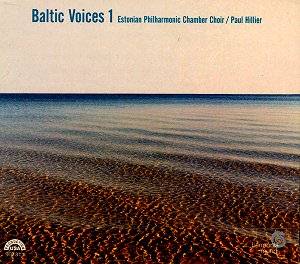Baltic
Voices indeed ... and from the last one hundred years. This first
disc in the exploratory series led by Paul Hillier turns its gaze
on secular and sacred music from Estonia, Latvia, Sweden and Finland.
Hillier
was appointed director of this choir in 2001. You can find more
about them at www.epcc.ee but
they were founded by Tōnu Kaljuste. They are strong in all
departments as is amply demonstrated by the burnished singing
in the second movement of the Kreek Psalms.
Kreek's
four movement Psalms of David stand between the
splendour of Rachmaninov's Vespers and Liturgy and
Bax's Mater Ora Filium. They bear strong resemblance to
both works though unison rather than multi-part singing is in
the ascendant. His choral writing may also remind you of that
of Veljo Tormis. Kreek is not, however, one for complexity. This
perhaps relates back to his grounding in Estonian folk music.
He was the first collector of Estonian folk music to use a phonograph. His
Requiem should be well worth seeking out.
The
Swedish composer Sandstrøm adopts a much more complex
skein of writing with multiform lines interacting with greater
lustre than in the Kreek. He transforms the Purcell original of
Hear my prayer into a staggering glower of sound.
Es ist genug quotes a Swedish song as well as a
passage from Buxtehude's cantata Eins bitte ich vom Herrn.
This is prayerful as well as something ‘rich and strange’.
At times it is as if Sandstrøm holds convention up to a
creative prism and re-tunes the light and life in each note. This
is especially true of the concentrated slowness of Es ist genug.
Rautavaara
has over the years moved with ease from tuneful to the ultima
thule boundaries of dodecaphony. His Lorca Suite is
harmonically rich and predominantly lyrical not that he shrinks
from getting the choir to slide and careen down and up the scales.
The work is full of a folk-like vigour drawn from the ‘Kalevala’
and related to Tormis whose use of the ‘Kalevipoeg’ the Estonian
counterpart of the Finns' ‘Kalevala’.
Tormis
is a familiar presence in the contemporary choral scene. He
tends towards the unison simplicity of Kreek but is by no means
pedantic. Folk voices are strong in his music. Another of his
hallmarks is the terracing of voices with semi-chorus effects,
solos and chamber choir gestures - linking to other traditions
such as the waulking and other work songs of the Gaelic North-West.
Neither is this folk culture preserved in aspic. Try the Midsummer
Song where great gales of intense lyrical sound burst the
bounds. This is the first recording of the Latvian Bourdon
Songs.
The
Pärt is the only piece to have words set in
English. It was written for Reykjavik's year as European City
of Culture (which comes to 'my' nearby Liverpool in 2008). After
years of ultra-serial works he emerged in the late 1970s with
works of spiritual tonality such as the Britten Cantus. The
piece featured here sets the words of the Bible. They recite the
lineage of Christ all the way back to Adam, son of God. It of
course repeats the words 'which was the son of ...' many times.
It is often extremely simple, a rocking and reassuring cradling.
Complexity, rather like Tippett's writing in The Windhover,
obtrudes from time to time. Forgive the trivial film reference
but I could not help thinking of the choral litany in the superb
sci-fi film Enemy Mine in which Dennis Quaid learns to
recite the lineage of 'Tsamis'.
The
Vasks is in one sense the 'odd man out' here in that it
is the only work on the disc in which the voices are accompanied
by an 18-strong chamber orchestra. This is strings only as is
the orchestra in his Violin Concerto (dedicated to Gidon Kremer).
What we have is a single quarter hour movement of the choral and
orchestral music radiating an undeniable and sustained brightness.
It is meditative and that element is accentuated by the Tallis-like
string writing. However in its intense climactic moments it will
also remind you of the great choral ‘conflagrations’ to be heard
in Moussorgsky and Rachmaninov (Sveshnikov's still unequalled
1965 recording of the Vespers, for example). Interestingly
Paul Hillier's notes comment on parallels with the Polish school
of the 1960s and on Vasks' grieving over the ecological destruction
wrought by the Soviets in Baltic waters.
The
words are printed in full alongside comprehensive notes in English,
French and German. The singing is allowed to ring out without
punches being pulled and the church resonance warms the listener's
heart.
These
lyrical yet always challenging works should be finding their way
onto the playlists of the world's radio stations and into the
programmes of choirs across the continents. They are not in any
sense 'ivory tower' products but welcome the listener with open
arms.
Rob
Barnett
